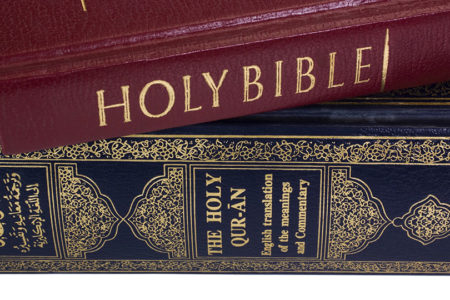The Rise of the Crescent: The Arabs and Islam
The Arabs of the Middle East are constantly in the news, one probable reason being that they control a major portion of the world’s petroleum. Islam, the religion most often associated with them, is growing at an amazing pace, even in the West. But who are the Arabs? What is their origin? How did most of them come to espouse the religion of Muhammad?
The first secular mention of this people was found in an Assyrian inscription, dated around 850 BC, that refers to a certain “Gindibu the Arab.” Quite appropriately, it describes him as contributing a thousand camels to a military effort. Sixteen biblical verses contain the words Arab, Arabian, or Arabia, the earliest reference being to “the kings of Arabia” who paid tribute to Solomon (1 Ki. 10:15). Arabians are also mentioned in a military context, fighting against various kings of Judah (e.g., Jehoshaphat (2 Chr. 17:11) and Jehoram (2 Chr. 21:16)). After the Babylonian captivity, various Arabians opposed Nehemiah’s rebuilding of Jerusalem’s walls (Neh. 2:19; 4:7; 6:1). The prophets also mentioned Arabia in their oracles of judgment (e.g., Isa. 21:13). The New Testament referred to Jews from Arabia (Acts 2:11) and mentioned Paul’s visit to that geographic region (Gal. 1:17).
The roots of this people who inhabited the Arabian Peninsula go back much further than these late biblical references. Before they were called Arabs, they were a people known for their nomadic wandering in the vast deserts south of the land of Israel. Both Jews and Arabs are called “Semites” (descendants of Shem, the son of Noah). In Genesis 10, the fascinating chapter called the “Table of Nations,” the 70 nations descended from Noah through Shem, Ham, and Japheth are named. One of these descendants was Eber (Gen. 10:21), from whom the two peoples later known as Arabs and Jews trace their ancestry. From Eber’s son Joktan came 13 descendants whose names are mentioned in Genesis 10:26–29. Some of those descendants (Sheba, Ophir, and Havilah) appear later in the Bible as names of places in the Arabian Peninsula. From these descendants of Joktan eventually came the nomadic Arabs of later history. It is interesting to note that even Islamic historians acknowledge that the Arabs are the “beni Qatan”—Arabic for the sons of Jobtan!
Eber also had another son, Peleg (Gen. 10:25), whose descendants are listed in Genesis 11:18–26. Concluding that list is a name more familiar to us—Abram. From this point, the biblical account centers almost exclusively on this man and his descendants, to whom God made many marvelous promises.
To summarize, the desert people later called Arabs are descendants of Eber through Joktan, while the Israelites trace their heritage back to Eber through Joktan’s brother, Peleg.
But this genealogical excursion does not exhaustively answer the questions regarding the identity and origin of the Arab people. To see the complete picture, we must look at the first two sons of Abraham—Ishmael and Isaac. The reader familiar with the biblical account will recall that Abram’s wife Sarai was barren (Gen. 16:1). Sarai therefore followed a custom of her day by asking her handmaid, the Egyptian Hagar, to go in to Abram so that Sarai could have a child who would be legally hers. But when Hagar became pregnant, she taunted the barren Sarai and was eventually put out of the camp. While she was heading home to Egypt across the forbidding desert sands of the Sinai Peninsula, the angel of the Lord tenderly and compassionately encountered this ancient equivalent of the modern single parent. The Lord encouraged her with the promise that her unborn child would be the father of a great multitude, and He instructed her to name the child Ishmael (Gen. 16:2–11).
Ishmael became the father of a line of desert people who joined with the already existing sons of Joktan to find the matrix of the people later known as Arabs. The prophecy that Ishmael would be a “wild man” (Gen. 16:12) refers to the wild donkeys that roamed the desert and were not owned by masters (see Job 6:5; 24:5; 39:5). This characterization was not meant to insult Ishmael or his descendants but to describe their unrestrained lifestyle in the open spaces of Sinai, where Ishmael’s descendants eventually, settled (see Gen. 25:18). They merged with the nomads who already lived there and in the Arabian Peninsula to the south, forming the later tribes of Arab people.
One other reference helps us understand the biblical origin of the Arabs. It is often forgotten that Abraham had another wife who was not mentioned until after Sarah’s death. Her name was Keturah, and 16 of her descendants are listed in Genesis 25:2–4. Two of the more prominent names in the list are Sheba (the Queen of Sheba, 1 Ki. 10) and Midian. The Midianites later appeared with the Ishmaelites as nomadic caravanners who took the young Joseph to Egypt (Gen. 37:28).
By now you may be overwhelmed by the sheer abundance of unfamiliar names. Perhaps the accompanying simplified charts will help you to understand their significance. It is important to recognize that the term Arab originally described nomadic desert people with roots in both Abraham’s family and the earlier sons of Joktan, all of whom were descendants of Eba, the Semite.
Although God confirmed His covenant of promise with Abraham’s son Isaac (Gen. 17:21) and Isaac’s son Jacob (Gen. 28:3–4), He promised that a truly great and powerful people would come from Ishmael as well (Gen. 17:20). Both of these promises have been graphically fulfilled in the subsequent histories of the Israelites and the Arabs.
Another question still remains unanswered. How did this vast Arab nation come to be followers of Muhammad, the prophet of Islam? It should first be noted that not all Arabs are Muslims. More than 100,000 Arabs call themselves Christians, most of whom are members of one of the Eastern Orthodox churches. Nevertheless the vast majority of Arabs do follow the religion of Islam.
In his book The Arabs: A Short History, Philip Hitti states, “The people of Arabia, particularly the Bedouins, have remained virtually the same throughout all recorded ages.” Isolated in that peninsula referred to as “The island of the Arabs,” their culture remained largely, unchanged for thousands of years. When Muhammad began to spread his doctrine of submission (i.e., Islam) to Allah, the Arabs of the peninsula were idolaters. Rebuffed at first by his fellow countrymen and also by the Jews this illiterate son of an itinerant tradesman pursued his mission with diligence and the sword. Along with his followers, he persuaded others, through military conquest, to follow his new creed. Before his death in 632 AD., he had defeated a number of Arab tribes gaining new converts with each victory. He defeated and massacred or banished those who rejected him, including Jews and Christians.
Muhammad’s successors, called “caliphs,” spread the word: “There is no god but Allah, and Muhammad is his prophet.” Like a powerful desert wind, those apostles burst out of the peninsula, conquering and converting virtually every people group of northern Africa and the Middle East. In less than a hundred years, the crescent of Islam flew over realms as far west as Spain and as far east as the steppes of Russia and the borders of China. The world had never witnessed such a vast and speedy conquest. While professing to permit “People of the Book” (i.e., Jews and Christians) to live and follow their own faiths, the Muslim conquerors converted pagans by the sword. All who accepted Allah and his prophet Muhammad became members of the “Dar al Islam” (world of Islam). Those other “People of the Book” (Jews and Christians) were reduced to second-class status and were forbidden to ever rule over Muslims within this Islamic world—a principle still followed today.
Within this new world, many non-Arab peoples were conquered and converted. The Egyptians and Berbers of North Africa, Persians, Russian tribes, Kurds, Afghans, and Turks were all included under the rule of the crescent. The Arab language was spread to many of those peoples, the primary vehicle of learning being the Koran, which was written and transmitted in Arabic. This spread of the Arab language and culture resulted in widespread “Arabization” of many originally non Arab peoples; thus, the term Arab came to include many groups who did not trace their ancestry back to Ishmael and Joktan. The modern definition of an Arab is one who speaks Arabic as his first language, a definition much broader than that of the original Arabs—those nomads of the Arabian Peninsula.
An early dispute about succession to leadership brought a division among the Muslims that survives to this day. The Iranians, along with many Iraqis and Lebanese, are Shiite Muslims, but the majority of Muslims are Sunnis. Whether Arabs or Persians, Semitic or African, Sunnis or Shiites, Muslims all agree with the tenet that there is one God (Allah) and the belief that Muhammad, the Arab, was his messenger.
The Arabs are a people characterized by a bewildering number of contradictions. Although characterized by a gracious sense of hospitality drawn from their Bedouin heritage, many Arabs can also be quite volatile and warlike. Although outwardly and loudly committed to Arab unity, Arabs have been known from time immemorial to slaughter each other in unceasing conflicts.
Understanding the Arab mind-set requires patience, diligence, and a commitment to genuine cross-cultural communication. But to really know them, especially the classic nomadic Arabs, is to successfully penetrate back to the days of the biblical patriarchs—those original “princes of the desert.”









I like this article and learn many things about islam and how people still saying that Islam is peaceful religion, but if we see the history and present islam is the most violent religion on this earth.
Am blessed with the passage. You have touched the topic that many Christians don’t understand about the origin of Arabs.